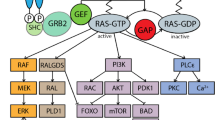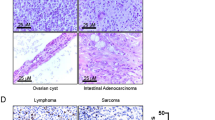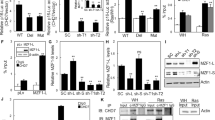Abstract
Oncogenic Ras expression is associated with activation of the DNA damage response (DDR) pathway, as evidenced by elevated DNA damage, primarily DNA double-strand breaks (DSBs), and activation of DNA damage checkpoints, which in primary human cells leads to entry into senescence. DDR activation is viewed as a physiological barrier against uncontrolled proliferation in oncogenic Ras-expressing cells, and arises in response to genotoxic stress due to the production of reactive oxygen species that damage DNA and to hyper-replication stress. Although oncogene-induced senescence (OIS) is considered a tumor suppressor mechanism, the accumulation of DNA damage in senescent cells is thought to cause genomic instability, eventually allowing secondary hits in the genome that promote tumorigenesis. To date, the molecular mechanisms behind DNA repair defects during OIS remain poorly understood. Here, we show that oncogenic Ras expression in human primary cells results in the downregulation of BRCA1 and 53BP1, two key factors in DNA DSB repair by homologous recombination and non-homologous end joining, respectively. As a consequence, Ras-induced senescent cells are hindered in their ability to recruit BRCA1 and 53BP1 to DNA damage sites. Whereas BRCA1 is downregulated at transcripts levels, 53BP1 loss is caused by activation of cathepsin L-mediated degradation of 53BP1 protein. Moreover, we discovered a marked downregulation of vitamin D receptor (VDR) during OIS, and a role for the vitamin D/VDR axis regulating the levels of these DNA repair factors during OIS. This study reveals a new functional relationship between the oncogene Ras, the vitamin D/VDR axis and the expression of DNA repair factors, in the context of OIS. The observed deficiencies in DNA repair factors in senescent cells could contribute to the genomic instability that allows senescence bypass and tumorigenesis.
This is a preview of subscription content, access via your institution
Access options
Subscribe to this journal
Receive 50 print issues and online access
$259.00 per year
only $5.18 per issue
Buy this article
- Purchase on Springer Link
- Instant access to full article PDF
Prices may be subject to local taxes which are calculated during checkout









Similar content being viewed by others
References
Campisi J . Suppressing cancer: the importance of being senescent. Science 2005; 309: 886–887.
Campisi J . Senescent cells, tumor suppression, and organismal aging: good citizens, bad neighbors. Cell 2005; 120: 513–522.
Serrano M, Lin AW, McCurrach ME, Beach D, Lowe SW . Oncogenic ras provokes premature cell senescence associated with accumulation of p53 and p16INK4a. Cell 1997; 88: 593–602.
Bartkova J, Rezaei N, Liontos M, Karakaidos P, Kletsas D, Issaeva N et al. Oncogene-induced senescence is part of the tumorigenesis barrier imposed by DNA damage checkpoints. Nature 2006; 444: 633–637.
Di Micco R, Sulli G, Dobreva M, Liontos M, Botrugno OA, Gargiulo G et al. Interplay between oncogene-induced DNA damage response and heterochromatin in senescence and cancer. Nat Cell Biol 2011; 13: 292–302.
Gorgoulis VG, Vassiliou LV, Karakaidos P, Zacharatos P, Kotsinas A, Liloglou T et al. Activation of the DNA damage checkpoint and genomic instability in human precancerous lesions. Nature 2005; 434: 907–913.
Aird KM, Zhang G, Li H, Tu Z, Bitler BG, Garipov A et al. Suppression of nucleotide metabolism underlies the establishment and maintenance of oncogene-induced senescence. Cell Rep 2013; 3: 1252–1265.
Bartek J, Bartkova J, Lukas J . DNA damage signalling guards against activated oncogenes and tumour progression. Oncogene 2007; 26: 7773–7779.
Di Micco R, Fumagalli M, Cicalese A, Piccinin S, Gasparini P, Luise C et al. Oncogene-induced senescence is a DNA damage response triggered by DNA hyper-replication. Nature 2006; 444: 638–642.
Mallette FA, Gaumont-Leclerc MF, Ferbeyre G . The DNA damage signaling pathway is a critical mediator of oncogene-induced senescence. Genes Dev 2007; 21: 43–48.
Mannava S, Moparthy KC, Wheeler LJ, Natarajan V, Zucker SN, Fink EE et al. Depletion of deoxyribonucleotide pools is an endogenous source of DNA damage in cells undergoing oncogene-induced senescence. Am J Pathol 2013; 182: 142–151.
Lee AC, Fenster BE, Ito H, Takeda K, Bae NS, Hirai T et al. Ras proteins induce senescence by altering the intracellular levels of reactive oxygen species. J Biol Chem 1999; 274: 7936–7940.
Weyemi U, Lagente-Chevallier O, Boufraqech M, Prenois F, Courtin F, Caillou B et al. ROS-generating NADPH oxidase NOX4 is a critical mediator in oncogenic H-Ras-induced DNA damage and subsequent senescence. Oncogene 2012; 31: 1117–1129.
Tu Z, Aird KM, Bitler BG, Nicodemus JP, Beeharry N, Xia B et al. Oncogenic RAS regulates BRIP1 expression to induce dissociation of BRCA1 from chromatin, inhibit DNA repair, and promote senescence. Dev Cell 2011; 21: 1077–1091.
Tu Z, Aird KM, Zhang R . Chromatin remodeling, BRCA1, SAHF and cellular senescence. Cell Cycle 2013; 12: 1653–1654.
Bouwman P, Aly A, Escandell JM, Pieterse M, Bartkova J, van der Gulden H et al. 53BP1 loss rescues BRCA1 deficiency and is associated with triple-negative and BRCA-mutated breast cancers. Nat Struct Mol Biol 2010; 17: 688–695.
Bunting SF, Callen E, Wong N, Chen HT, Polato F, Gunn A et al. 53BP1 inhibits homologous recombination in Brca1-deficient cells by blocking resection of DNA breaks. Cell 2010; 141: 243–254.
Cao L, Xu X, Bunting SF, Liu J, Wang RH, Cao LL et al. A selective requirement for 53BP1 in the biological response to genomic instability induced by Brca1 deficiency. Mol Cell 2009; 35: 534–541.
King MC, Marks JH, Mandell JB . Breast and ovarian cancer risks due to inherited mutations in BRCA1 and BRCA2. Science 2003; 302: 643–646.
Morales JC, Xia Z, Lu T, Aldrich MB, Wang B, Rosales C et al. Role for the BRCA1 C-terminal repeats (BRCT) protein 53BP1 in maintaining genomic stability. J Biol Chem 2003; 278: 14971–14977.
Aly A, Ganesan S . BRCA1, PARP, and 53BP1: conditional synthetic lethality and synthetic viability. J. Mol Cell Biol 2011; 3: 66–74.
Kass EM, Moynahan ME, Jasin M . Loss of 53BP1 is a gain for BRCA1 mutant cells. Cancer cell 2010; 17: 423–425.
Lowndes NF . The interplay between BRCA1 and 53BP1 influences death, aging, senescence and cancer. DNA Repair (Amst) 2010; 9: 1112–1116.
Grotsky DA, Gonzalez-Suarez I, Novell A, Neumann MA, Yaddanapudi SC, Croke M et al. BRCA1 loss activates cathepsin L-mediated degradation of 53BP1 in breast cancer cells. J Cell Biol 2013; 200: 187–202.
Croke M, Neumann MA, Grotsky DA, Kreienkamp R, Yaddanapudi SC, Gonzalo S . Differences in 53BP1 and BRCA1 regulation between cycling and non-cycling cells. Cell Cycle 2013; 12: 3629–3639.
Gonzalez-Suarez I, Redwood AB, Grotsky DA, Neumann MA, Cheng EH, Stewart CL et al. A new pathway that regulates 53BP1 stability implicates cathepsin L and vitamin D in DNA repair. EMBO J 2011; 30: 3383–3396.
Redwood AB, Gonzalez-Suarez I, Gonzalo S . Regulating the levels of key factors in cell cycle and DNA repair: new pathways revealed by lamins. Cell Cycle 2011; 10: 3652–3657.
Redwood AB, Perkins SM, Vanderwaal RP, Feng Z, Biehl KJ, Gonzalez-Suarez I et al. A dual role for A-type lamins in DNA double-strand break repair. Cell Cycle 2011; 10: 2549–2560.
Collette J, Ulku AS, Der CJ, Jones A, Erickson AH . Enhanced cathepsin L expression is mediated by different Ras effector pathways in fibroblasts and epithelial cells. Int J Cancer 2004; 112: 190–199.
Denhardt DT, Greenberg AH, Egan SE, Hamilton RT, Wright JA . Cysteine proteinase cathepsin L expression correlates closely with the metastatic potential of H-ras-transformed murine fibroblasts. Oncogene 1987; 2: 55–59.
Goulet B, Sansregret L, Leduy L, Bogyo M, Weber E, Chauhan SS et al. Increased expression and activity of nuclear cathepsin L in cancer cells suggests a novel mechanism of cell transformation. Mol Cancer Res 2007; 5: 899–907.
Urbanelli L, Trivelli F, Ercolani L, Sementino E, Magini A, Tancini B et al. Cathepsin L increased level upon Ras mutants expression: the role of p38 and p44/42 MAPK signaling pathways. Mol Cell Biochem 2010; 343: 49–57.
Klein HL . The consequences of Rad51 overexpression for normal and tumor cells. DNA Repair (Amst) 2008; 7: 686–693.
Yuan SS, Chang HL, Lee EY . Ionizing radiation-induced Rad51 nuclear focus formation is cell cycle-regulated and defective in both ATM(-/-) and c-Abl(-/-) cells. Mutat Res 2003; 525: 85–92.
Mao Z, Tian X, Van Meter M, Ke Z, Gorbunova V, Seluanov A . Sirtuin 6 (SIRT6) rescues the decline of homologous recombination repair during replicative senescence. Proc Natl Acad Sci USA 2012; 109: 11800–11805.
Rozenchan PB, Folgueira MA, Katayama ML, Snitcovsky IM, Brentani MM . Ras activation is associated with vitamin D receptor mRNA instability in HC11 mammary cells. J Steroid Biochem Mol Biol 2004; 92: 89–95.
Taber LM, Adams LS, Teegarden D . Mechanisms of nuclear vitamin D receptor resistance in Harvey-ras-transfected cells. J Nutr Biochem 2009; 20: 629–637.
Campbell MJ, Gombart AF, Kwok SH, Park S, Koeffler HP . The anti-proliferative effects of 1alpha,25(OH)2D3 on breast and prostate cancer cells are associated with induction of BRCA1 gene expression. Oncogene 2000; 19: 5091–5097.
Deng C, Ueda E, Chen KE, Bula C, Norman AW, Luben RA et al. Prolactin blocks nuclear translocation of VDR by regulating its interaction with BRCA1 in osteosarcoma cells. Mol Endocrinol 2009; 23: 226–236.
Dusso AS, Brown AJ, Slatopolsky E . Vitamin D. Am J Physiol Renal Physiol 2005; 289: F8–28.
Haussler MR, Whitfield GK, Kaneko I, Haussler CA, Hsieh D, Hsieh JC et al. Molecular mechanisms of vitamin D action. Calcif Tissue Int 2013; 92: 77–98.
Collado M, Serrano M . Senescence in tumours: evidence from mice and humans. Nat Rev Cancer 2010; 10: 51–57.
Suram A, Kaplunov J, Patel PL, Ruan H, Cerutti A, Boccardi V et al. Oncogene-induced telomere dysfunction enforces cellular senescence in human cancer precursor lesions. EMBO J 2012; 31: 2839–2851.
Gocheva V, Joyce JA . Cysteine cathepsins and the cutting edge of cancer invasion. Cell Cycle 2007; 6: 60–64.
Jedeszko C, Sloane BF . Cysteine cathepsins in human cancer. Biol Chem 2004; 385: 1017–1027.
Skrzydlewska E, Sulkowska M, Koda M, Sulkowski S . Proteolytic-antiproteolytic balance and its regulation in carcinogenesis. World J Gastroenterol 2005; 11: 1251–1266.
Deeb KK, Trump DL, Johnson CS . Vitamin D signalling pathways in cancer: potential for anticancer therapeutics. Nat Rev Cancer 2007; 7: 684–700.
Narvaez CJ, Matthews D, LaPorta E, Simmons KM, Beaudin S, Welsh J . The impact of vitamin D in breast cancer: genomics, pathways, metabolism. Front Physiol 2014; 5: 213.
Salomon DG, Fermento ME, Gandini NA, Ferronato MJ, Arevalo J, Blasco J et al. Vitamin D receptor expression is associated with improved overall survival in human glioblastoma multiforme. J Neurooncol 2014; 118: 49–60.
Srinivasan M, Parwani AV, Hershberger PA, Lenzner DE, Weissfeld JL . Nuclear vitamin D receptor expression is associated with improved survival in non-small cell lung cancer. J Steroid Biochem Mol Biol 2011; 123: 30–36.
Carey LA, Perou CM, Livasy CA, Dressler LG, Cowan D, Conway K et al. Race, breast cancer subtypes, and survival in the Carolina Breast Cancer Study. JAMA 2006; 295: 2492–2502.
Nesby-O'Dell S, Scanlon KS, Cogswell ME, Gillespie C, Hollis BW, Looker AC et al. Hypovitaminosis D prevalence and determinants among African American and white women of reproductive age: third National Health and Nutrition Examination Survey, 1988-1994. Am J Clin Nutr 2002; 76: 187–192.
Yao S, Ambrosone CB . Associations between vitamin D deficiency and risk of aggressive breast cancer in African-American women. J Steroid Biochem Mol Biol 2013; 136: 337–341.
Gonzalo S . Novel roles of 1alpha,25(OH)D on DNA repair provide new strategies for breast cancer treatment. J Steroid Biochem Mol Biol 2013; 144: 59–64.
Farmer H, McCabe N, Lord CJ, Tutt AN, Johnson DA, Richardson TB et al. Targeting the DNA repair defect in BRCA mutant cells as a therapeutic strategy. Nature 2005; 434: 917–921.
Fong PC, Boss DS, Yap TA, Tutt A, Wu P, Mergui-Roelvink M et al. Inhibition of poly(ADP-ribose) polymerase in tumors from BRCA mutation carriers. N Engl J Med 2009; 361: 123–134.
Helleday T, Bryant HE, Schultz N . Poly(ADP-ribose) polymerase (PARP-1) in homologous recombination and as a target for cancer therapy. Cell Cycle 2005; 4: 1176–1178.
Jaspers JE, Kersbergen A, Boon U, Sol W, van Deemter L, Zander SA et al. Loss of 53BP1 causes PARP inhibitor resistance in Brca1-mutated mouse mammary tumors. Cancer Discov 2013; 3: 68–81.
Rottenberg S, Jaspers JE, Kersbergen A, van der Burg E, Nygren AO, Zander SA et al. High sensitivity of BRCA1-deficient mammary tumors to the PARP inhibitor AZD2281 alone and in combination with platinum drugs. Proc Natl Acad Sci USA 2008; 105: 17079–17084.
Gonzalez-Suarez I, Redwood AB, Perkins SM, Vermolen B, Lichtensztejin D, Grotsky DA et al. Novel roles for A-type lamins in telomere biology and the DNA damage response pathway. EMBO J 2009; 28: 2414–2427.
Zhang J, Ma Z, Treszezamsky A, Powell SN . MDC1 interacts with Rad51 and facilitates homologous recombination. Nat Struct Mol Biol 2005; 12: 902–909.
Author information
Authors and Affiliations
Corresponding author
Ethics declarations
Competing interests
The authors declare no conflict of interest.
Additional information
Supplementary Information accompanies this paper on the Oncogene website
Supplementary information
Rights and permissions
About this article
Cite this article
Graziano, S., Johnston, R., Deng, O. et al. Vitamin D/vitamin D receptor axis regulates DNA repair during oncogene-induced senescence. Oncogene 35, 5362–5376 (2016). https://doi.org/10.1038/onc.2016.77
Received:
Revised:
Accepted:
Published:
Issue Date:
DOI: https://doi.org/10.1038/onc.2016.77
This article is cited by
-
Cellular senescence and frailty: a comprehensive insight into the causal links
GeroScience (2023)
-
Beyond DNA repair and chromosome instability—Fanconi anaemia as a cellular senescence-associated syndrome
Cell Death & Differentiation (2021)
-
Vitamin D receptor (VDR) and metabolizing enzymes CYP27B1 and CYP24A1 in breast cancer
Molecular Biology Reports (2020)
-
Hypovitaminosis D exacerbates the DNA damage load in human uterine fibroids, which is ameliorated by vitamin D3 treatment
Acta Pharmacologica Sinica (2019)
-
Fanconi anemia proteins counteract the implementation of the oncogene-induced senescence program
Scientific Reports (2019)



